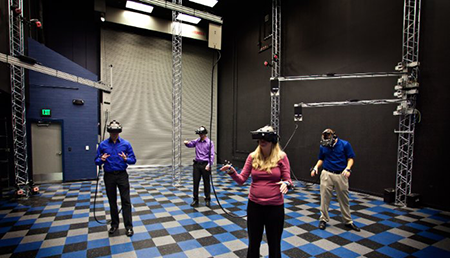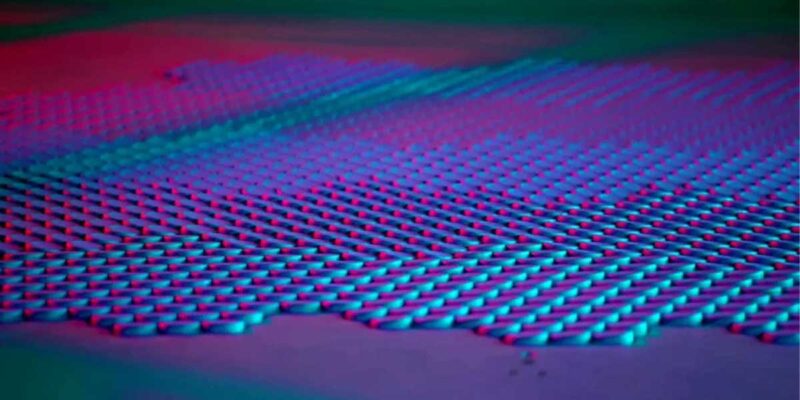Don’t Fall in Love with the Technology, Fall in Love with Your Goals
By James Gruening
Mechdyne Corporation
 A recent Wall Street Journal article, “Virtual Reality Isn’t Just About Games,” by Christopher Mims, made several predictions about the future of virtual reality technology. However, there were a couple of points that Mims missed.
A recent Wall Street Journal article, “Virtual Reality Isn’t Just About Games,” by Christopher Mims, made several predictions about the future of virtual reality technology. However, there were a couple of points that Mims missed.
First, head mounted displays (HMDs) are not the only way to experience virtual reality (VR). For many uses, they are the ideal tool. In other cases, there are better tools to achieve your goals. It’s easy to get swept away with the glamour and “coolness” of high end technology, but technology is a catalyst for greater things. Remember: don’t fall in love with the technology, fall in love with your goals. If the technology is appealing but can’t do what you need it to, it’s worthless.
Second, and more importantly, VR isn’t the future. It’s now. VR has already permeated most major industries, from oil and gas to higher education. At Mechdyne, we’ve been helping clients use VR and visualization systems to enable discovery for the past 19 years.
The Solution is Key
We don’t ask our clients what technology they want. We ask what problem they’re trying to solve and recommend a solution (usually including technology) that will perform the best for their specific use case.
Because of their increasing visibility in the consumer realm, HMDs are what most people think of when they hear “virtual reality.” However, various organizations that use VR as a business tool tend to opt for larger immersive systems, such as a CAVE™ or a Powerwall™. There are benefits and disadvantages to both options. HMDs take up less space at a much lower cost, but aren’t as collaborative and users may experience issues with peripheral vision. Large systems may offer a more immersive experience and can accommodate larger groups of people, but they take up more space and require a larger upfront investment.
VR to Support Training
These larger systems aren’t in the public eye nearly as often because businesses, not consumers, are buying and utilizing them. As Mims pointed out, VR has broad appeal as a training tool for dangerous, expensive, or similarly problematic jobs or situations. In fact, we have designed VR systems that are used for military exercises, mine safety training, and medical simulations. Still, training is only one of the countless ways VR can be beneficial in the real world. As VR becomes more advanced, businesses and organizations are finding it essential in architecture and construction design, manufacturing, energy discovery, research and education, and entertainment.
VR to Support Prototyping and Manufacturing
Top vehicle manufacturers have minimized the use of physical vehicle prototypes –
today they build virtual prototypes, saving substantial design time and investment costs. Virtual prototypes allow designers to see their vehicle from every angle. They can move to the side to see something better, crouch down, or walk around the model, while tracking technology reacts to their movements. This allows them to identify design issues, and then quickly and easily make changes to the prototype at no extra cost. Design evaluations which used to take days or even weeks can now be done in hours, with no physical production whatsoever.
VR to Support Education and Research
Educational institutions tend to have the most diverse portfolio of VR applications. It seems professors, students, and researchers from any discipline can find a way to augment their work using virtual reality. Scientists at Monash University explore atoms, travel through the solar system, and are able to review research results which used to take two weeks in just two hours. The University of Wyoming’s aspiring art historians examine classic pieces in detail while the originals sit thousands of miles away. Later that day, a team of geologists use the same system to look inside the layers of the earth in search of oil deposits. Commercial partners use the University of Arkansas at Little Rock’s VR system to review and optimize building designs. This provides a 5-10 percent building cost saving due to minimized errors which used to be identified during the actual construction of the building.
No matter the purpose, VR users experience countless benefits. In most cases, the cost savings and project time reduction alone are more than enough to deem the system a success. Of course, there are also other unmeasurable advantages to implementing VR, like the ability to see and scale miniscule or enormous objects, viewing the inside of something that wouldn’t be possible physically, and virtually traveling to far away cities, ecosystems, and even planets.
Enhance Human Interaction through Virtual Teleconferencing
Virtual travel has another widely sought after use – virtual teleconferencing. As Mims suggested, virtual teleconferencing can be a viable alternative to video conferencing. However, his vision of a piece of technology in which you exist as an avatar ignores the most crucial aspect of virtual teleconferencing. To me, that sounds like the humans in the movie Wall-E who sit while their technology does everything for them. Virtual teleconferencing is a tool to enhance human interaction, not replace it. The key purpose of VR in a meeting is to share and collaborate. For example, two teammates in Chicago could teleconference with the rest of their team in Boston, all of whom could view and interact with the same virtual model in real time.
It’s Not Just About HMDs
Another aspect of VR technology often left out of consumer discussions are larger immersive VR systems, which for many organizations are an alternative to HMDs. As HMDs get smaller and smaller to cater to consumers’ preferences, these systems get larger and larger to enable increasingly more realistic VR experiences. Users—or groups of users—are free of cords and heavy equipment, needing only a pair of 3D glasses and sometimes hand-held controllers. In many cases, immersive VR environments provide more true-to-life experiences than HMDs.
Virtual reality is nothing new; it has been shaping the way that major industries function for years now. Although until now VR had played only a small role in the consumer world, it has for years been implemented into the workflow of various organizations. Both HMDs and large VR systems will continue to evolve and adapt to new uses and challenges. It’s important to remember it is not about the technology, it is about achieving your goals, needs, expectations, and dreams.
James Gruening is the Co-Founder and Senior Vice President of Mechdyne. For more information on Mechdyne’s technology solutions go here.





